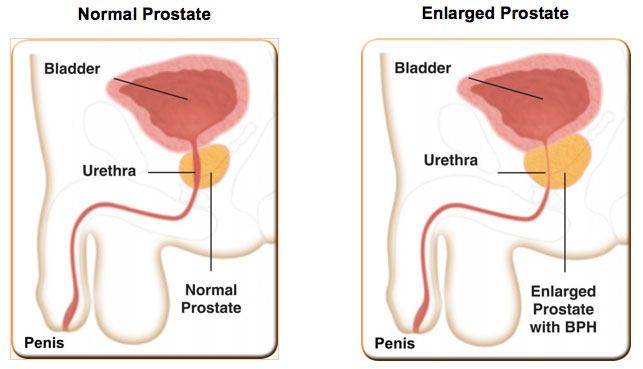Prostate Conditions
Benign Prostatic Hypertrophy (Enlarged Prostate)
Benign prostatic hypertrophy is also known as benign prostatic hyperplasia (BPH). BPH is a non-cancerous enlargement of the prostate gland, which produces ejaculatory fluid.
Common Symptoms
- Inability to urinate
- Pain during urination
- A sensation of “incomplete emptying” of the bladder
- Urinary incontinence
Treatment Options
There are many treatments available for men suffering from BPH. At Mount Sinai your physician will prescribe the treatment that best addresses your particular condition and symptoms. Our treatments include:
- Electrosurgical removal (TURP) – In this procedure, an instrument called a resectoscope is inserted through the tip of the penis and into the urethra, which is the tube that carries urine to the bladder. Then, using the rectoscope, your urologist will remove excess prostate tissue.
- Laser vaporization (Greenlight Laser). This minimally invasive procedure uses a laser to vaporize excess prostate tissue.
- Medications
- Rezum – This procedure uses a sterile steam, which is injected into the enlarged portions of the prostate.
- ThermoTherapy – This procedure uses microwave energy to destroy excess prostate tissue.
- UroLift System – This treatment uses tiny implants to lift and hold back prostate tissue.
What is BPH?
Benign Prostatic Hyperplasia, or BPH, is a condition in which the prostate enlarges as men get older. Over 70% of men in their 60s have BPH symptoms so it is very common1. While BPH is a benign condition and unrelated to prostate cancer, it can greatly affect a man’s quality of life.
The prostate is a male reproductive gland, about the size of a walnut, that produces fluid for semen. The prostate surrounds the urethra, which is the tube that carries urine from the bladder out of the body. As the prostate enlarges, it presses on and blocks the urethra, causing bothersome urinary symptoms such as:
- Frequent need to urinate both day and night
- Weak or slow urinary stream
- A sense that you cannot completely empty your bladder
- Difficulty or delay in starting urination
- Urgent feeling of needing to urinate
- A urinary stream that stops and starts
If you suffer from the above symptoms, you are not alone. BPH is one of the leading reasons for men to visit a urologist2.
BPH Treatment Options
If you have been diagnosed with an enlarged prostate due to BPH, there are several treatment options available. Consult your physician to determine which treatment is right for you.
Watchful Waiting
When symptoms are mild, your doctor may just monitor your condition and ask you to track your symptoms before deciding if any treatment is necessary.
Medications
Your doctor may prescribe medications to manage your symptoms. These medications include alpha blockers which relax the muscles around the neck of your bladder, making it easier to urinate, and alpha reductase inhibitors which act to shrink the prostate. While medications can be helpful in relieving symptoms for some men, patients must continue taking them long-term to maintain the effects.
Some patients may suffer side-effects including dizziness, headaches, or sexual dysfunction. Some may not get adequate relief of their symptoms. Over 16% of men on medication for BPH discontinue treatment early for reasons such as being dissatisfied with side-effects or not getting adequate symptom relief.3
UroLift® System Treatment
The UroLift® System treatment is a minimally invasive approach to treating BPH that lifts or holds the enlarged prostate tissue out of the way so it no longer blocks the urethra. There is no cutting, heating or removal of prostate tissue. Clinical data has shown that the UroLift System treatment is safe and effective in relieving lower urinary tract symptoms due to BPH without any impact to sexual function.
Learn more about how the UroLift System treatment works or visit our FAQ page for more information on the benefits, risks, and recovery.
Thermotherapies
Thermotherapies are minimally invasive treatments where heat energy such as microwave or radiofrequency is applied to destroy prostate tissue. Less invasive than TURP, these treatments are generally safe, can be performed under local anesthesia and provide moderate symptom relief for some patients.
Applying high heat to the prostate can cause tissue swelling and uncomfortable urinary symptoms during the healing period. Symptom relief does not occur immediately, and patients often need to have a catheter that is attached to a urine bag inserted into their bladder during the recovery period.
Laser
Laser Resection of the Prostate
TURP may be performed with a laser in procedures called photoselective vaporization of the prostate (PVP) or holmium laser enucleation (HOLEP). Laser therapy lessens the bleeding risks of traditional TURP. However, since prostate tissue is still removed, there can be tissue swelling and an uncomfortable healing time. Typically, a catheter has to be inserted into the bladder after the procedure.
Surgery
Transurethral Resection of the Prostate (TURP)
TURP is the most common surgery to treat BPH. During this procedure, patients undergo general anesthesia, and prostate tissue is removed. TURP is often considered the “gold standard” for long-term results.
After prostate tissue has been removed, the body needs time to heal. The remaining prostate tissue may actually swell and become inflamed before the desired shrinking effect occurs. Patients may suffer an uncomfortable recovery period that includes short-term problems
such as bleeding, infection, erectile dysfunction, and urinary incontinence. Patients have to
have a catheter that is attached to a urine bag inserted into their bladder for several days after the procedure.
Symptom relief may not occur immediately, but lasts for a long time in many patients once it does occur.
There can be long-term side effects after TURP such as dry orgasm (retrograde ejaculation), erectile dysfunction or incontinence (leaking of urine).
UroLift® System
What is the UroLift System?
The UroLift® System treatment is a revolutionary, minimally invasive approach to treating an enlarged prostate, or BPH, that lifts or holds the enlarged prostate tissue out of the way so it no longer blocks the urethra. There is no cutting, heating or removal of prostate tissue.
Clinical data has shown that the UroLift System treatment is safe and effective in relieving lower urinary tract symptoms due to BPH without compromising sexual function6. The goal of the UroLift System treatment is to relieve symptoms so you can get back to your life and resume your daily activities.
Most common side effects are light blood in the urine, some pain or discomfort when urinating, some increased urge to go and discomfort in the pelvis that typically resolve within two to four weeks after the procedure.
Advantages of the UroLift System:
- Rapid symptom relief, better than reported for medications4
- Risk profile better than reported for surgical procedures such as TURP5
- Preservation of sexual function1
- Return to normal activity in days not months
- Increased quality of life
- No ongoing BPH medications
- 19 clinical study publications; 4 years published clinical data6
How the UroLift works:
The UroLift System treatment is a straightforward procedure that is performed by a urologist. The urologist places tiny implants to hold the prostate lobes apart, like open curtains on a window, to relieve compression on the urethra. This allows urine to flow normally again. The UroLift System treatment can be done in the physician’s office under local anesthesia. Typically, patients return home the same day without a catheter.4
- Berry, et al., Journal of Urology 1984
- IMS Health Urology 2013
- NeoTract US market model estimates for 2016 based on IMS Health and Drug Procedure Data
- Roehrborn J Urology 2013; 2003 AUA Guidelines
- Sonksen J Urology 2016
- Roehrborn Urology Clinics 2016
Prostate Cancer
Prostate cancer is a tumor that forms within the prostate tissues, a gland in the male reproductive system. Prostate cancer usually occurs in older men and may or may not cause symptoms.
Common Symptoms
- Difficulty getting an erection
- Elevated prostate-specific antigen (PSA)
- Urination problems
Treatment Options
Depending on the size and stage of cancer, treatment options include the following:
- Active monitoring
- Chemotherapy
- Combination multimodality therapy
- Hormone therapy
- Immunotherapy & molecular targeted therapy
- Medication
- Radiation therapy
- Robotic surgery
- Surgery
Prostatitis
Prostatitis is a rapidly developing inflammation or infection of the prostate gland. Bacterial infections such as urinary tract infections or sexually transmitted infections usually cause this inflammation or infection. Prostatitis is a term that covers four types of clinical conditions:- Acute bacterial prostatitis
- Asymptomatic prostatitis
- Chronic bacterial prostatitis
- Chronic prostatitis
- Blood in the urine
- Fever and chills
- Pain in the abdomen and lower back
- Painful ejaculation or urination
- Alpha-blockers and anticholinergic medication for urinary issues
- Antibiotics for bacterial infections
- Natural anti-inflammatories for noninfectious prostatic inflammation
- Physical therapy for pelvic muscle dysfunction
Our Physicians
- Mount Sinai Medical Center (Main Campus)
- 305.674.2499
- Mount Sinai Primary & Specialty Care Midtown
- 786.598.4560
Akshay Bhandari, MD
Shelia & Charles D. Saunders, M.D, F.A.C.S.
Co-Chief, Columbia University Division of Urology at Mount Sinai Medical Center
Director, Robotic Surgery
Assistant Professor at the Columbia University Division of Urology at Mount Sinai Medical Center
- Urology
- Cancer
- Oncology
- Robotic Surgery
- Urologic Oncology
- Mount Sinai Medical Center (Main Campus)
- 305.674.2499
- Mount Sinai Emergency Center, Physician Offices, Cancer Center and Diagnostic Center Aventura
- 305.692.1080
Alan M Nieder, MD
Shelia & Charles D. Saunders, M.D, F.A.C.S.
Co-Chief, Columbia University Division of Urology at Mount Sinai Medical Center
Program Director, Urology Residency Program
Associate Professor at the Columbia University Division of Urology at Mount Sinai Medical Center
- Urology
- Cancer
- Oncology
- Urologic Oncology
- Robotic Surgery
- Mount Sinai Medical Center (Main Campus)
- 305.674.2499
- Mount Sinai Emergency Center, Physician Offices, Cancer Center and Diagnostic Center Aventura
- 305.692.1080
- Mount Sinai Specialty Care Key West I Cardiology, Urology & Vascular Care
- 305.294.8334
- Mount Sinai Cardiology of the Florida Keys, Marathon
- 305.289.2910
Billy H Cordon-Galiano, MD
Director, Urologic Reconstruction, Trauma, and Prosthetics
- Urology
- Men’s Health
- Robotic Surgery
- Mount Sinai Medical Center (Main Campus)
- 305.674.2499
- Mount Sinai Primary & Specialty Care Skylake
- 305.919.1970
- Mount Sinai Medical Center, Kenneth C. Griffin Center, Hialeah – Emergency Center and Primary & Specialty Care | Mount Sinai Eldercare
- 786.584.5555
- Mount Sinai Primary & Specialty Care Midtown
- 786.598.4560
- Mount Sinai Primary & Specialty Care Coral Gables
- 305.441.0910







